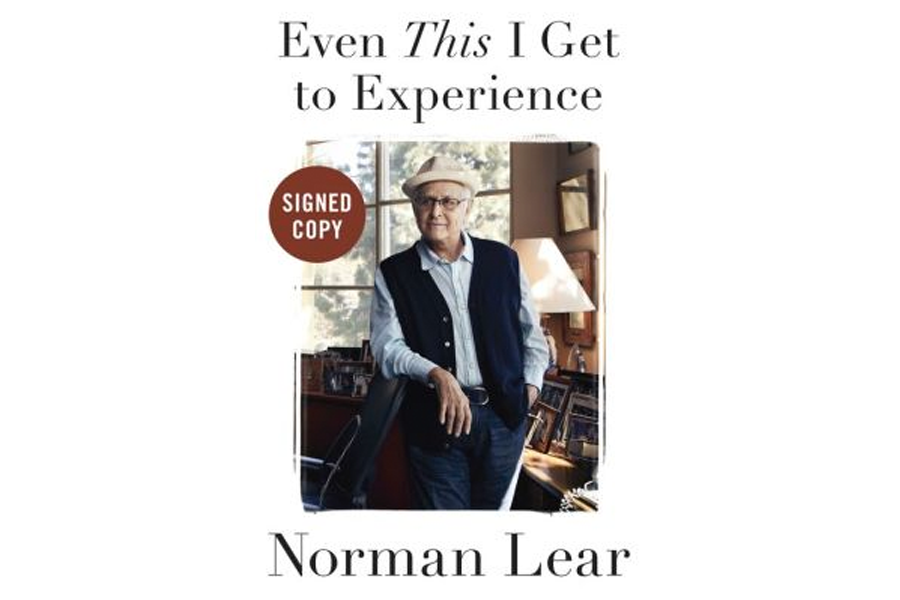'Even This I Get to Experience' tells the story of TV genius Norman Lear
Loading...
Norman Lear was the creative force behind "All in the Family," "Maude," "Sanford and Son," "Good Times," "The Jeffersons," and "Mary Hartman, Mary Hartman," so it’s no surprise that the man knows how to tell a good story. His richly entertaining autobiography, Even This I Get to Experience, is full of them.
Lear’s deeply flawed parents cast a heavy shadow over the proceedings – apparently, even multimillionaire celebrity nonagenarians can still hunger for parental approval – but they’re often fodder for comedy. He opens the book in 1983, when he learns that he is to be included in the first class of inductees into the Academy of Television Arts and Sciences’ new Hall of Fame, with the likes of Edward Murrow, William Paley, Milton Berle, and Lucille Ball. His mother’s response, when he calls to share the good news? “Listen, if that’s what they want to do, who am I to say?”
Unlike his cold and sour mother, Lear’s father, H.K., didn’t live long enough to express bewilderment at his son’s success. While he writes with bitterness about his mother, Lear retains a gauzy reverence for his father, who served three years in prison for dealing in fake bonds when Norman was a boy. Once out of jail, H.K. moved from one hopeless business scheme to the next, “failing forward and upward,” Lear writes in a nice turn of phrase, “each venture grander than the last.” It took Lear years to accept that his father wasn’t simply a “rascal,” as his worshipful son liked to think of him, but a liar and a fraud.
Lear escaped his unhappy home life with a scholarship to Emerson College; he dropped out to enlist in World War II, serving as a radio operator and gunner on dozens of B-17 combat missions over Germany. After the war, once he extricated himself from an ill-fated business partnership with his father, Lear set out for California to launch a career in publicity. He ended up writing for radio and television instead. Working with his partner Ed Simmons, Lear enjoyed a three-year stint with Dean Martin and Jerry Lewis – living on Seconal and Dexedrine, he recalls, to keep up with the demands of live television in its heady and chaotic early days – until the mercurial Lewis fired them without explanation. Lear went on to write for Martha Raye, Tennessee Ernie Ford, and George Gobel before he and Bud Yorkin formed the production company, Tandem, through which Lear’s seminal ’70s hits would be created.
The section of the book covering those hits is, as one might expect, the strongest, full of backstage anecdotes that will delight fans and reflections on the significance of the boundary-breaking programs. When Lear heard of a British show, "Till Death Us Do Part," about a bigoted father and his liberal son, he became obsessed with creating an American version inspired by his relationship with his own father, who used to call Norman the “laziest, dumbest white kid” he’d ever met. It’s impossible now to imagine anyone but Carroll O’Connor playing Archie Bunker, but Lear’s first choice was Mickey Rooney. Offered the role, Rooney had this priceless reply: “Norm, they’re going to kill you, shoot you dead in the streets. You want to do a TV show with the Mick, listen to this: Vietnam vet. Private eye. Short. Blind. Large dog.” (While Lear gives O’Connor due credit for his brilliant portrayal, their relationship was “murderously difficult” from the start. Similarly, clashes over content with cast members of "Good Times," which presented the first full black family on television, made that show, Lear writes, “an agony to produce.”)
One only has to be reminded of where "All in the Family" initially fell in the Tuesday-night lineup to grasp what a cultural shift it represented: upon its January 1971 debut, it was preceded by "The Beverly Hillbillies," "Green Acres," and "Hee Haw." Lear was battling the CBS censors up until 20 minutes before the first broadcast – over a plot point that seems positively quaint today – promising to quit if his work was altered. He was forced to repeat that threat often throughout the years, as his shows took on topics including abortion, racism, impotence, premarital sex, and religion. But in response to those who, by accusing him of using television as a political platform, suggest that everything that came before was devoid of political content, he argues, “For twenty years – until "AITF" came along – TV comedy was telling us there was no hunger in America, we had no racial discrimination, there was no unemployment or inflation, no war, no drugs..... Tell me that expressed no point of view!”
Lear is, of course, also known for his explicitly political activities. The book’s final section details his founding of People for the American Way, a liberal advocacy group formed to counter the influence of the religious Right (full if minor disclosure: I worked at PFAW for several years in the early 1990s and briefly met Lear), and his 2001 purchase of an original copy of the Declaration of Independence, which he put on display in all 50 states. While book’s end finds the 92-year-old author becoming overly sentimental, his treacly description of his third marriage is more forgivable than his unnecessarily unkind descriptions of the first two. Lear’s distinctly modern family includes five daughters and a son, ranging in age from 19 to 68. He confesses to being a distracted father to the older set when his career was in highest gear. But it’s clear as he writes about his television shows – with affection, frustration, anguish, and love – that they were his children, too.








